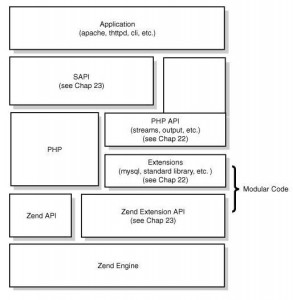SAPI: Server abstraction API,研究過PHP架構的同學應該知道這個東東的重要性,它提供了一個接口,使得PHP可以和其他應用進行交互數據。 本文不會詳細介紹每個PHP的SAPI,只是針對最簡單的CGI SAPI,來說明SAPI的機制。
首先,我們來看看PHP的架構圖:

圖1 PHP Architecture
SAPI提供了一個和外部通信的接口, 對於PHP5.2,默認提供了很多種SAPI, 常見的給apache的mod_php5,CGI,給IIS的ISAPI,還有Shell的CLI,本文就從CGI SAPI入手 ,介紹SAPI的機制。 雖然CGI簡單,但是不用擔心,它包含了絕大部分內容,足以讓你深刻理解SAPI的工作原理。
要定義個SAPI,首先要定義個sapi_module_struct, 查看 PHP-SRC/sapi/cgi/cgi_main.c:
*/
static sapi_module_struct cgi_sapi_module = {
#if PHP_FASTCGI
"cgi-fcgi", /* name */
"CGI/FastCGI", /* pretty name */
#else
"cgi", /* name */
"CGI", /* pretty name */
#endif
php_cgi_startup, /* startup */
php_module_shutdown_wrapper, /* shutdown */
NULL, /* activate */
sapi_cgi_deactivate, /* deactivate */
sapi_cgibin_ub_write, /* unbuffered write */
sapi_cgibin_flush, /* flush */
NULL, /* get uid */
sapi_cgibin_getenv, /* getenv */
php_error, /* error handler */
NULL, /* header handler */
sapi_cgi_send_headers, /* send headers handler */
NULL, /* send header handler */
sapi_cgi_read_post, /* read POST data */
sapi_cgi_read_cookies, /* read Cookies */
sapi_cgi_register_variables, /* register server variables */
sapi_cgi_log_message, /* Log message */
NULL, /* Get request time */
STANDARD_SAPI_MODULE_PROPERTIES
};
這個結構,包含了一些常量,比如name, 這個會在我們調用php_info()的時候被使用。一些初始化,收尾函數,以及一些函數指針,用來告訴Zend,如何獲取,和輸出數據。
1. php_cgi_startup, 當一個應用要調用PHP的時候,這個函數會被調用,對於CGI來說,它只是簡單的調用了PHP的初始化函數:
static int php_cgi_startup(sapi_module_struct *sapi_module)
{
if (php_module_startup(sapi_module, NULL, 0) == FAILURE) {
return FAILURE;
}
return SUCCESS;
}
2. php_module_shutdown_wrapper , 一個對PHP關閉函數的簡單包裝。只是簡單的調用php_module_shutdown;
3. PHP會在每個request的時候,處理一些初始化,資源分配的事務。這部分就是activate字段要定義的,從上面的結構我們可以看出,對於CGI來說,它並沒有提供初始化處理句柄。對於mod_php來說,那就不同了,他要在apache的pool中注冊資源析構函數, 申請空間, 初始化環境變量,等等等等。
4. sapi_cgi_deactivate, 這個是對應與activate的函數,顧名思義,它會提供一個handler, 用來處理收尾工作,對於CGI來說,他只是簡單的刷新緩沖區,用以保證用戶在Zend關閉前得到所有的輸出數據:
static int sapi_cgi_deactivate(TSRMLS_D)
{
/* flush only when SAPI was started. The reasons are:
1. SAPI Deactivate is called from two places: module init and request shutdown
2. When the first call occurs and the request is not set up, flush fails on
FastCGI.
*/
if (SG(sapi_started)) {
sapi_cgibin_flush(SG(server_context));
}
return SUCCESS;
}
5. sapi_cgibin_ub_write, 這個hanlder告訴了Zend,如何輸出數據,對於mod_php來說,這個函數提供了一個向response數據寫的接口,而對於CGI來說,只是簡單的寫到stdout:
static inline size_t sapi_cgibin_single_write(const char *str, uint str_length TSRMLS_DC)
{
#ifdef PHP_WRITE_STDOUT
long ret;
#else
size_t ret;
#endif
#if PHP_FASTCGI
if (fcgi_is_fastcgi()) {
fcgi_request *request = (fcgi_request*) SG(server_context);
long ret = fcgi_write(request, FCGI_STDOUT, str, str_length);
if (ret <= 0) {
return 0;
}
return ret;
}
#endif
#ifdef PHP_WRITE_STDOUT
ret = write(STDOUT_FILENO, str, str_length);
if (ret <= 0) return 0;
return ret;
#else
ret = fwrite(str, 1, MIN(str_length, 16384), stdout);
return ret;
#endif
}
static int sapi_cgibin_ub_write(const char *str, uint str_length TSRMLS_DC)
{
const char *ptr = str;
uint remaining = str_length;
size_t ret;
while (remaining > 0) {
ret = sapi_cgibin_single_write(ptr, remaining TSRMLS_CC);
if (!ret) {
php_handle_aborted_connection();
return str_length - remaining;
}
ptr += ret;
remaining -= ret;
}
return str_length;
}
把真正的寫的邏輯剝離出來,就是為了簡單實現兼容fastcgi的寫方式。
6. sapi_cgibin_flush, 這個是提供給zend的刷新緩存的函數句柄,對於CGI來說,只是簡單的調用系統提供的fflush;
7.NULL, 這部分用來讓Zend可以驗證一個要執行腳本文件的state,從而判斷文件是否據有執行權限等等,CGI沒有提供。
8. sapi_cgibin_getenv, 為Zend提供了一個根據name來查找環境變量的接口,對於mod_php5來說,當我們在腳本中調用getenv的時候,就會間接的調用這個句柄。而對於CGI來說,因為他的運行機制和CLI很類似,直接調用父級是Shell, 所以,只是簡單的調用了系統提供的genenv:
static char *sapi_cgibin_getenv(char *name, size_t name_len TSRMLS_DC)
{
#if PHP_FASTCGI
/* when php is started by mod_fastcgi, no regular environment
is provided to PHP. It is always sent to PHP at the start
of a request. So we have to do our own lookup to get env
vars. This could probably be faster somehow. */
if (fcgi_is_fastcgi()) {
fcgi_request *request = (fcgi_request*) SG(server_context);
return fcgi_getenv(request, name, name_len);
}
#endif
/* if cgi, or fastcgi and not found in fcgi env
check the regular environment */
return getenv(name);
}
9. php_error, 錯誤處理函數, 到這裡,說幾句題外話,上次看到php maillist 提到的使得PHP的錯誤處理機制完全OO化, 也就是,改寫這個函數句柄,使得每當有錯誤發生的時候,都throw一個異常。而CGI只是簡單的調用了PHP提供的錯誤處理函數。
10. 這個函數會在我們調用PHP的header()函數的時候被調用,對於CGI來說,不提供。
11. sapi_cgi_send_headers, 這個函數會在要真正發送header的時候被調用,一般來說,就是當有任何的輸出要發送之前:
static int sapi_cgi_send_headers(sapi_headers_struct *sapi_headers TSRMLS_DC)
{
char buf[SAPI_CGI_MAX_HEADER_LENGTH];
sapi_header_struct *h;
zend_llist_position pos;
if (SG(request_info).no_headers == 1) {
return SAPI_HEADER_SENT_SUCCESSFULLY;
}
if (cgi_nph || SG(sapi_headers).http_response_code != 200)
{
int len;
if (rfc2616_headers && SG(sapi_headers).http_status_line) {
len = snprintf(buf, SAPI_CGI_MAX_HEADER_LENGTH,
"%s\r\n", SG(sapi_headers).http_status_line);
if (len > SAPI_CGI_MAX_HEADER_LENGTH) {
len = SAPI_CGI_MAX_HEADER_LENGTH;
}
} else {
len = sprintf(buf, "Status: %d\r\n", SG(sapi_headers).http_response_code);
}
PHPWRITE_H(buf, len);
}
h = (sapi_header_struct*)zend_llist_get_first_ex(&sapi_headers->headers, &pos);
while (h) {
/* prevent CRLFCRLF */
if (h->header_len) {
PHPWRITE_H(h->header, h->header_len);
PHPWRITE_H("\r\n", 2);
}
h = (sapi_header_struct*)zend_llist_get_next_ex(&sapi_headers->headers, &pos);
}
PHPWRITE_H("\r\n", 2);
return SAPI_HEADER_SENT_SUCCESSFULLY;
}
12. NULL, 這個用來單獨發送每一個header, CGI沒有提供
13. sapi_cgi_read_post, 這個句柄指明了如何獲取POST的數據,如果做過CGI編程的話,我們就知道CGI是從stdin中讀取POST DATA的,
static int sapi_cgi_read_post(char *buffer, uint count_bytes TSRMLS_DC)
{
uint read_bytes=0, tmp_read_bytes;
#if PHP_FASTCGI
char *pos = buffer;
#endif
count_bytes = MIN(count_bytes, (uint) SG(request_info).content_length - SG(read_post_bytes));
while (read_bytes < count_bytes) {
#if PHP_FASTCGI
if (fcgi_is_fastcgi()) {
fcgi_request *request = (fcgi_request*) SG(server_context);
tmp_read_bytes = fcgi_read(request, pos, count_bytes - read_bytes);
pos += tmp_read_bytes;
} else {
tmp_read_bytes = read(0, buffer + read_bytes, count_bytes - read_bytes);
}
#else
tmp_read_bytes = read(0, buffer + read_bytes, count_bytes - read_bytes);
#endif
if (tmp_read_bytes <= 0) {
break;
}
read_bytes += tmp_read_bytes;
}
return read_bytes;
}
14. sapi_cgi_read_cookies, 這個和上面的函數一樣,只不過是去獲取cookie值:
static char *sapi_cgi_read_cookies(TSRMLS_D)
{
return sapi_cgibin_getenv((char *) "HTTP_COOKIE", sizeof("HTTP_COOKIE")-1 TSRMLS_CC);
}
15. sapi_cgi_register_variables, 這個函數給了一個接口,用以給$_SERVER變量中添加變量,對於CGI來說,注冊了一個PHP_SELF,這樣我們就可以在腳本中訪問$_SERVER['PHP_SELF']來獲取
本次的request_uri:
static void sapi_cgi_register_variables(zval *track_vars_array TSRMLS_DC)
{
/* In CGI mode, we consider the environment to be a part of the server
* variables
*/
php_import_environment_variables(track_vars_array TSRMLS_CC);
/* Build the special-case PHP_SELF variable for the CGI version */
php_register_variable("PHP_SELF", (SG(request_info).request_uri ? SG(request_info).request_uri : ""), track_vars_array TSRMLS_CC);
}
16. sapi_cgi_log_message ,用來輸出錯誤信息,對於CGI來說,只是簡單的輸出到stderr:
static void sapi_cgi_log_message(char *message)
{
#if PHP_FASTCGI
if (fcgi_is_fastcgi() && fcgi_logging) {
fcgi_request *request;
TSRMLS_FETCH();
request = (fcgi_request*) SG(server_context);
if (request) {
int len = strlen(message);
char *buf = malloc(len+2);
memcpy(buf, message, len);
memcpy(buf + len, "\n", sizeof("\n"));
fcgi_write(request, FCGI_STDERR, buf, len+1);
free(buf);
} else {
fprintf(stderr, "%s\n", message);
}
/* ignore return code */
} else
#endif /* PHP_FASTCGI */
fprintf(stderr, "%s\n", message);
}
經過分析,我們已經了解了一個SAPI是如何實現的了, 分析過CGI以後,我們也就可以想象mod_php, embed等SAPI的實現機制。 :)
怎麼樣,本文介紹的是不是非常詳細,希望大家喜歡。